How To Repair Damaged Cinder Block Wall
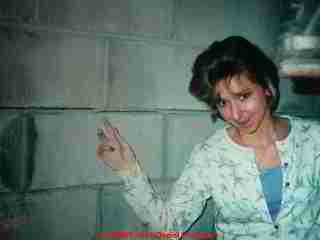 Types of Cracks in Block Foundation Walls
Types of Cracks in Block Foundation Walls
Fissure detection & crack evaluation
- Postal service a QUESTION or Annotate about damaged concrete block foundations: causes, fissure & movement patterns, diagnosis, repair, inspection procedures
InspectAPedia tolerates no conflicts of interest. Nosotros have no relationship with advertisers, products, or services discussed at this website.
Damaged masonry block foundations & walls:
How to Inspect & Diagnose Concrete Block Foundation Cracks, Leans, Bows, Settlement.
This article explains concrete block or "cinder block" or concrete masonry unit (CMU) foundation inspection procedures and the diagnosis of cracks, bulges, leaning, bowing, and settlement in physical block foundations and building walls such as damage due to impact, settlement, frost or water damage, and other causes.
Types of foundation cracks, crack patterns, differences in the meaning of cracks in different foundation materials, site weather condition, building history, and other evidence of building move and harm are described to assist in recognizing foundation defects and to assist the inspector carve up cosmetic or depression-take chances atmospheric condition from those likely to be important and potentially plush to repair.
We besides provide an ARTICLE INDEX for this topic, or you can try the page height or lesser SEARCH BOX as a quick way to notice information you lot demand.
How to Identify, Diagnose, & Evaluate Masonry Block (physical & "cinder block") Foundation & Wall Impairment
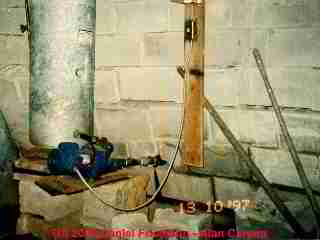
Article Series Contents
- Block FOUNDATION & WALL DEFECTS
- BULGED, COLLAPSING MASONRY Block WALLS
- DIAGONAL or STEP CRACKS in Cake WALLS
- HORIZONTAL CRACKS in Cake WALLS
- VERTICAL CRACKS in Block WALLS
- SPALLING CONCRETE Cake WALLS & CHIMNEYS
- SUMMARY of KEY DEFECTS in CONCRETE Cake STRUCTURES
[Click to enlarge any image]
Bulged, collapsing concrete block walls

The masonry cake foundation at the house in these photographs collapsed after a period of heavy rain. The underlying problem was in-slope grade at the rear of the home and trapped roof spillage there, causing lots of heavy wet world pressure on the wall.
The dwelling house inspector had previously observed water damage at the wall and had correctly assessed the outside weather.
The owners had deferred activeness to forbid further water damage, leading to an unexpected and sudden precipitous plummet of the foundation later a period of unusually moisture weather condition.
Photograph below: photograph courtesy of Alan Carson , Carson Dunlop, Toronto. The photos above and below are of two unlike buildings.
Diagonal Cracks or Step Cracks in Cake Walls & Foundations
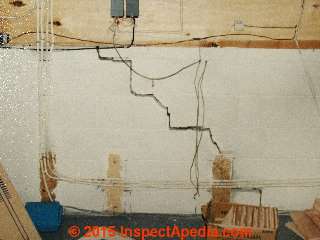
A diagonal crack tin appear in many structural materials and components including block, brick, and concrete foundation walls, chimneys, and and building interior drywall or plaster.
Diagonal bully unremarkably indicates actual vertical movement in the structure or differential settlement: diagonal groovy in masonry structures commonly indicates differential settlement, occasionally frost heaves and more than rarely the development of a sink pigsty under or almost the foundation.
Our photo higher up, discussed
at VERTICAL Move IN FOUNDATIONS,
illustrates severe structural damage to a concrete block foundation wall.
Closer inspection shows both stair-footstep slap-up and bulging in this wall, probably due to water and frost pressure from outside.
Diagonal cracks (actually in the form of a stair-footstep in masonry-unit walls) can appear anywhere in a wall but most often they appear virtually the building corners.
Explanations for the diagonal or stair-pace cracks in physical blocks or bricks nearly a corner include at to the lowest degree these factors:
- Vertical movement is being acquired by settlement, frost, or a sink pigsty or expansive clay soils under and near the foundation wall;
- The added resistance to move afforded by the nearby intersecting wall at the corner causes dandy to appear in a stair-step form following the mortar joints in the concrete block or brick whereas the same settlement or heaving forces might have caused more near-vertical cracks if they had occurred closer to the center of the wall.
In our concrete block wall crack photo shown beneath you lot can see both stride cracks at the wall corner and a horizontal crevice at the bottom of the upper one/iii of the wall - describing what I recall is just this condition.
- In areas of freezing weather condition or expansive soils, spilling of a roof drainage organisation downspout by the building corner may exist concentrating water in that location.
Run into DIAGONAL CRACKS in BLOCK FOUNDATIONS, WALLS for details about diagonal cracks in both concret block and poured concrete foundation walls and for advice near evaluating the severity of damage.
Come across DIAGONAL Footstep Corking in Block or BRICK FOUNDATIONS for more details.
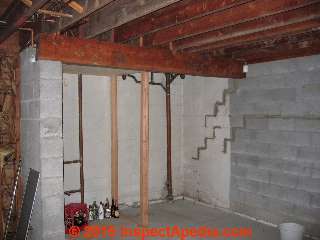
Cracks occurring near foundation corners in a masonry block wall are often from water and frost. In freezing climates, "frost lensing" tin cause soil to stick to and lift a building foundation when the footing freezes.
These cracks are usually visible in the portion of the concrete cake foundtion that remains above grade. The forces at piece of work and this stair-step plus horizontal block wall cleft pattern are described in point #two of the discussion just above.
Horizontal Cracks in Masonry Block Walls
Horizontal cracks in a physical cake wall are more than immediately threatening of serious collapse than vertical cracks.
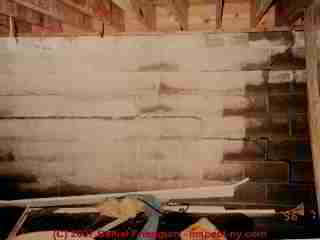
But for pocket-sized horizontal cracks (say 1/sixteen" wide) and walls that have minimal bowing (say < 1" inwards) the block wall foundation collapse risk approximate may be reduced.
And where history indicates that the impairment is old, perchance from a single event (damaged during backfill, for case) and not ongoing, the urgency of repair may also be reduced.
See Block FOUNDATION BACKFILL DAMAGE
An assessment of these factors as well as the effect on the residual of the structure are important.
The photo at above eft illustrates severe bulging in a concrete block foundation wall. The location of the cracks combined with outside ascertainment of backfill level suggests this harm is due to water, frost, and earth force per unit area.

In masonry cake construction, foundation or wall cracks occur more than commonly in mortar joints merely can likewise occur across and through the blocks themselves.
At left we illustrate a wide horizontal crack along the mortar joint of a concrete cake foundation wall. The wall too is bulged inwards; measurements showing more than in inch of inwards bow meant that practiced evaluation (and likely reconstruction) were in society for this construction.
Vertical Cracking in Physical Cake Walls
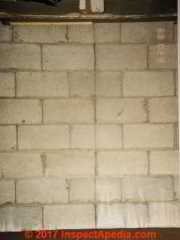
Vertical cracks in block foundation walls & expansion and shrinkage cracks in a concrete block wall may occur simply are less mutual than in another materials.
The National Physical Masonry Clan, in TEK 10-1A (NCMA 2005) describes these types of shrinkage that can cause peachy in concrete masonry walls:
- Drying shrinkage in concrete blocks or masonry units
- Temperature-fluctuation shrinkage in concrete block walls or foundations
- Carbonation shrinkage in masonry block walls
Spotter out: more-dramatic physical block wall impairment tin occur from external forces such equally impact or earth loading.
In a higher place: a very direct vertical crack in a concrete cake foundation wall, extending from the basement floor slab to the summit of the foundation wall.
Details well-nigh the causes of vertical cracks in concrete cake walls, and the possible causes and need for remedy or repair for this cleft damage are discussed
at VERTICAL CRACKS in BLOCK WALLS
Besides see VERTICAL MOVEMENT IN FOUNDATIONS
Spalling Concrete Cake Walls & Foundations
Spalling is divers as the flaking off or loss of material in masonry block, brick, concrete or other masonry structures, usually caused by the action of freezing h2o that has penetrated the masonry surface. Spalling damage ranges from cosmetic to serious, costly and dangerous.
Spalling concrete block may tell u.s. about the the history of building construction, movement, events tin can help diagnose concrete block foundation cracks & harm.
If there is superficial spalling of the block - less than three/4" deep into the block surface, and if in that location is no bulging, cracking, settlement, move, burdensome, and so nigh likely we're talking about a water entry and moisture issue and a corrective effect. Below the spalling concrete block foundation wall damage is in my opinion superficial and cosmetic, not structural, but it does tell us
- that there has been h2o or roof spillage past the foundation wall
- at that place may be water entry inside the basement or crawl expanse of the building
- that someone knew of this condition every bit the foundation in one of the photos was painted with a masonry sealer.
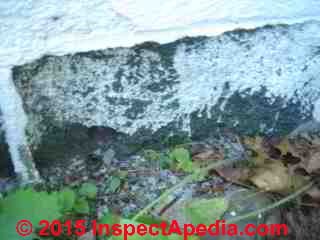
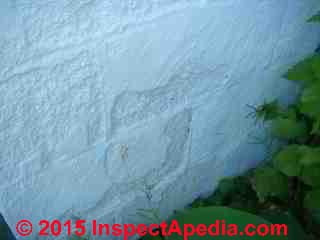
The photos of spalling concrete block foundation walls shown higher up were contributed by Kinston NY home inspector Arlene Puentes.
See Almost AuditApedia.com for her contact information.
We utilize the term concrete blocks in these articles where others may refer to this same construction cloth equally concrete masonry unit (CMU), masonry blocks, cement blocks, or cinder blocks. Concrete blocks vary in quality, more often than not as a function of the era in which they were made and the raw materials used.
Structural Damage From Spalling Concrete or Masonry Block
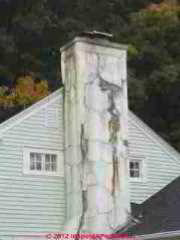
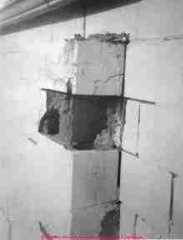
At above left the chimnney has been badly damaged by frost: fifty-fifty inspecting from the ground we can run into cracks, movement, spalling concrete blocks, and stains indicating that the flue interior is leaking to the chimney outside.
This is an unsafe chimney risking burn or other damage: inspection and repair or replacement are urgently needed.
The photograph at above correct illustrates severe spalling impairment to a concrete block pilaster. This is enough damage to be considered a structural concern every bit the pilaster is part of the construction supporting the building above.
Some concrete cake, peculiarly older masonry block containing a high percentage of sand, cinders, or dirt and not enough concrete may exist more vulnerable to water damage and spalling damage.
Henry Page Sr. in Poughkeepsie, NY in the early 1900's dug up the family farm, mixed dirt, cinders, and cement using a Sears & Roebuck cinder block kit to make masonry blocks that were used throughout Dutchess Canton.
In time many of these blocks spalled and disintegrated badly where they were exposed to rain splash-upward at ground level. But rarely did these flimsy versions of the mod (and harder, stronger, physical block) atomic number 82 to a building failure from their innate properties.
Rather most building failures involving physical block are our own mistake - causes which we inventory in this article serial.
Spalling brick at chimneys and at structural or veneer walls are discussed separately at
CHIMNEY SPALLING
and at BRICK WALL FROST & H2o CRACKS, EFFLORESENCE, SPALLING
Key Defects List for Concrete Cake Walls
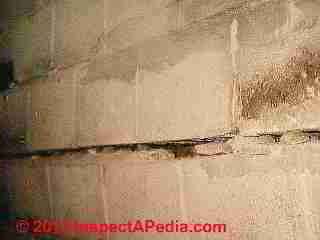 Some common masonry cake (or "concrete cake" or "cinder block") foundation or structural wall defects to be observed and reported include:
Some common masonry cake (or "concrete cake" or "cinder block") foundation or structural wall defects to be observed and reported include:
- Leaning or tipping masonry block walls: a concrete cake or concrete masonry unit (CMU) wall may tip inwards at its pinnacle (a leaning or tipping wall failure) due to force per unit area from water and moisture soils, from frost, from the weight of nearby vehicles driving forth the wall (oil truck coming to deliver heating oil), or past defects and tipping wall footings.
- Buckled concrete block walls: oft due to pressure level or loading from water, frost, earth, or nearby passage of vehicles - potentially urgent depending on circumstances and amount.
Bulging or buckling masonry block wall failures (shown at to a higher place-left) are also called "bending" failures.
- Horizontal displacement or "shear failures" occur in physical block walls, particularly ones which were built without vertical steel reinforcement, and may be caused by pressure from water and wet soils or other forces.
If we observe portions of a wall sliding horizontally past other wall segments nosotros've plant a shear failure.
A common shear failure tin can be seen when the bottom form of masonry blocks in a foundation wall is held in place by a flooring slab and when the upper portion of the wall has been pushed inwards so that the upper blocks are projecting past the lower ones.
Such walls are also frequently tipping or leaning or may be buckled and broken open along horizontal mortar joints in the wall.
- Cracks in concrete block walls: along the mortar joints, or less often correct through the masonry blocks themselves, tin exist the result of pressure from water and wet soils, frost, nearby vehicles, or differential settlement in a ground.
If a foundation wall crack is vertical and fairly uniform in width, but the wall on one side of the crack is higher than on the other, we're looking at differential settlement which will probably be traced to the footings.
If a foundation wall crack is vertical and wider at its top than its bottom, we may be looking at ground settlement in which the footings have "bent" and settled unevenly, such every bit when a ground has been placed over unevenly compacted fill or where there was bedrock or a large boulder nether a portion of the footing permitting settlement such that the ground has settled down on one or both sides of this "high point".
At least one author as well posed that a physical masonry unit wall which has a vertical crevice almost its heart and whose crack is wider at its peak than bottom has cracked due to wall shrinkage forth its length.
His explanation was that the top of the wall was costless to shrink but its bottom was held in place by the footing, making a crack wider at top than bottom. However other experts (D.Wickersheim) assert that concrete block walls do not compress significantly during curing, though moisture masonry blocks might change a scrap in dimension during drying.
- Crack patterns in concrete or other masonry foundation walls tin can occur as vertical, diagonal, stair-stepped, or horizontal patterns which nosotros discuss and amidst which we distinguish in more detail
at FOUNDATION CRACK DICTIONARY
- Missing components such every bit headers where the wall has been modified, steel reinforcement wire or re-bar (if required by local codes).
- Missing footings, piers or other reinforcement
- Impact damage which has cleaved masonry blocks or dislocated them
- Point loading cracks or fractures
- Other cracks through or across concrete blocks as opposed to bang-up in the mortar joints. Unlike poured physical, concrete blocks do not compress with historic period or curing. When investigating cracks through concrete blocks, check the other possibilities.
- Poured concrete sister walls, additions of pilasters, additions of steel reinforcement, or repeated re-coating of a wall with parging cement are all indications of past harm and/or water entry problems that merit further evaluation
Reader Q&A - also see the FAQs series linked-to below
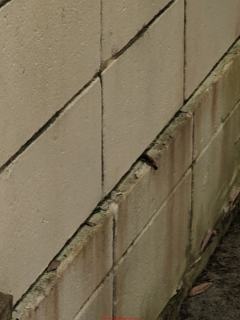 @Greg Read,
@Greg Read,
Give thanks you for an interesting cake wall keen question.
Photograph: example of a damaged concrete block wall with horizontal cracking and meaning deportation: this is NOT Greg's wall that he describes below.
Strapping lone may non be a safe block wall repair
While I must say that an on-site expert will always find of import information this missing from a question like this, and that that would about certainly change the prescription,
from but what y'all've described so far, it seems very unlikely that any cake wall reinforcement strapping such y'all described would really terminate the wall from continuing impairment.
Even if you put on so much reinforcement that the bully stopped in its present location, you lot're simply transferring the forces of movement so that the cracks volition announced nearby instead.
It sounds as if the underlying trouble is not the fabric of the concrete block wall but rather that the wall was improperly constructed and is bulging, or leaning, or both.
Safety warnings for leaning or bulging block walls
Watch out: a bulging concrete block walls with horizontal smashing is at risk of sudden catastrophic collapse: injuring anyone nearby and damaging holding.
If a block wall has horizontal neat merely bulging (and/or leaning) is (are) very slight in-place repair by reinforcement may be reasonable.
A severely leaning or bulged wall is a more-serious and dangerous situation.
While there is no unmarried "always-right" reply to "how much bulge is dangerous", at a national conference I helped organize (decades ago) the consensus among engineers and other experts in the room of about 200 attendees, was that if a wall is bulged in or leaning an inch or more the damage is serious, and if the bulge or leaning is two-inches or more the situation is an immediate take a chance.
BULGE or LEAN MEASUREMENTS provides piece of cake ways to measure out just how much a cake wall has leaned or bulged.
Accurate diagnosis of cause for bulged, cracked, leaning block wall is needed
A half dozen meter high wall, is a big and very heavy construction needing an aplenty basis, and needing vertical reinforcement, typically equally steel re-bar in grouted vertical openings in the wall, spaced at intervals specified by the pattern engineer or architect.
Leaning due to an inadequate or improperly-congenital footing, OR omission of internal reinforcement, OR exposure to some horizontal external force can all produce horizontal cracks in physical block walls.
And so it makes sense to diagnose that trouble and decide on a repair form instead of applying a Band-aid that won't be effective.
We discuss typical methods used to reinforce a bulging block wall
at BULGED FOUNDATION REPAIR METHODS
if yous can utilise the "Add Image" push button to post a photo of your wall and the damaged expanse I can, perchance, offer other useful comment.
I have a vi meter high boundry wall that appears to accept a 400 mm ring beam half fashion up.
In that location are ii continious horizontal cracks running the entire width of the boundry wall. I have tried several methods to seal these cracks from standard filler to epidermix.
Zippo prevents the cracks from reoccuring.
I am cosidering fitting st. steel straps 6mm 10 75.mm 10 2meter over the ring beam held in place by xvi mm threaded rod every 1,5 mtr apart. Volition this secure the wall integrity?
Clearly the top department is non joined to the beam.
The wall is approx. 15 meter long and I don't see whatever buttress stabilizing it other then the cease walls.
@Chuck Abode Inspector,
Cheers, that's interesting and something we'll be certain to keep with the commodity on block wall crack diagnosis.
I agree. I think that fifty-fifty though the wall was parged, the mortar joints are arresting more moisture than the blocks themselves, hence the superficial cracking;
Practise you find that the harm is only in the parge coat?
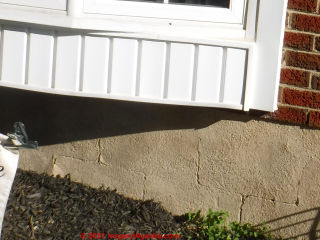
You can diagnose that by finding (or making) a spot where the parge coating is removed around 1 of those cracks; then examine the mortar and mortar articulation themselves for signs of cracking or move.
Also look at the roof drainage system, gutters, leaders, for signs of roof spillage and water splash-up along the foundation.
In NJ I find cracking at the mortar joints of CMU foundations. [Photo above]
The cracks outline the block at the joints. Oftentimes institute at moisture to very wet foundations. The swell is more on the outside wall than on the interior wall. I am thinking it is due to the chronic water in the joints freezing and expanding over decades of winters.
This is usually not with large horizontal, vertical or stair step smashing. The cracks seldom go through the blocks themselves. More a failure in the mortar. Thank y'all for any information on what acquired this.
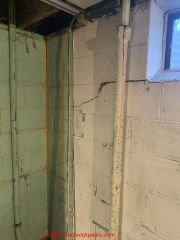 @Jolie, I agree. We desire to know:
@Jolie, I agree. We desire to know:
- the issue of foundation movement on the construction - and thus an assessment of seriousness
- the history and cause of dandy - and thus a approximate at whether or not a cure is needed and if so, what
From that crack pattern I'd look with care at both walls for leaning - BULGE or LEAN MEASUREMENTS https://inspectapedia.com/structure/Foundation_Bulge_Lean_Measurement.php
may assistance
One crack among many in a home nosotros just purchased. Seller has just completed waterproofed the exterior, laid new drain tile and backfilled with stone & will add fortress stabilizing straps to cracked walls. I call back nosotros need more assist though
Cheers for the info, the aid is much appreciated.
@Anonymous,
And so if we know the cause that helps alot - car bumped wall -
Survey the whole wall and decide if you need to supersede the intel - if so that'll ascertain the repair.
Thanks for responding! I believe the prior owners bumped the adjoining wall with their auto, so I'thou non concerned virtually ongoing move (if that'southward what you lot were referring to). Expert catch on the window header, I'll investigate! Appreciate it.
Holly
That looks to me like movement in the wall from an underlying crusade that needs to exist establish and fixed before anybody thinks of patching.
If this is the simply damage, and noticing that it'south over a window, I doubtable an inadequate header or lintel that's sagging and needs replacement.
Hello! I'chiliad wondering about a fracture in a non-foundation terra cotta cake wall (freestanding garage). It's difficult to notice info about this type of block! I'grand hoping to insulate the roof and pretty certain this fracture will need to be repaired beginning. I believe it happened when the bordering wall was damaged, probably by a auto (a large segment of the bordering wall was rebuilt with cinderblocks). I'd appreciate any advice on repair for this fracture, cheers!
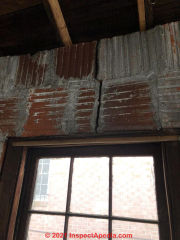
Re-posting from blocked commen t
by Kay [delete] [approve]
I'g looking to place an offering on home that looks similar it may accept serious foundation issues. You can see a video clip of it starting at vi min into the video. Realtor states it looks like water damage, and the crack runs pretty far. Whatever idea of a ballpark estimate on this prepare? To come across the video...
Moderator reply:
Kay you posted a link to a blurry video that, with apologies, makes me nauseous with its movement when I try to sentry it - that's not going to be helpful nor something I on which I tin comment.
You might endeavor post a specific, articulate photo of a business and we may exist able to do better.
Thanks for the info, the assistance is much appreciated.
Sam:
That looks like a vertical crack extending down both a mortar joint and right through a cake, all about the tiptop of the wall.
Typically this is constitute when a foundation settles over a point (a stone, pipe, etc) ;
If the crack does non extend down to and through the bottom of the wall, doesn't appear in the flooring slab, and if the wall is not leaning, angle, bowing, bulged, and then I suspect this is old settlement and not a major dislocation; you'd seal information technology and watch it for farther move and keep water away from the wall outside.
In the ARTICLE Index you'll find articles on measuring wall movement and cracks giving details for using a string, level, measuring tape, to see if there is detectable wall movement. If in that location were an inch or and so and so aye you'd want to bring in an experienced bricklayer or a structural or civil engineer who had experience and expertise in residential block foundations.
Removed a wall in our lower level (1975 split level in Maryland) to expose this fissure. It comes from the corner of a window. The ground level is located perhaps an inch or ii from the bottom of the window. Not sure if it'due south something I can fix myself or if I should have an proficient handle it and was hoping someone hither can help.
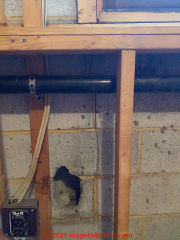
Cheers as well, Jim for taking the fourth dimension to write a prissy note.
I've worked hard on this data for nearly xl years, and at InspectApedia.com since 2005, so I'k particularly grateful when a reader finds information technology useful.
We also much welcome criticism, corrections, content suggestions, questions.
Daniel
Thank for sharing the valuable data regarding the foundation and how its repair nd much more. It help to solve the rel life problems
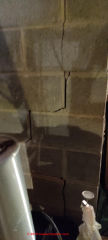 MC
MC
I doubtable there is some basis settlement or frost heave going on.
Take a await at VERTICAL CRACKS IN FONDATIONS
https://inspectapedia.com/construction/Vertical_Movement_in_Foundations.php
We recently discovered some cracks in our business firm (foundation is wall bricks / cake) and were wondering if we can fix them or how severe the harm is to brainstorm with.
The house is in Ontario, facing harsh winters and hot summers. Information technology'south build on rock, flake of a gradient.
There is some soil covering the surface, but don't know exactly since we are the 2nd owners. Wondering if someone can give us some early advice. Many Many
Cheers in accelerate. See more pictures here: https://drive.google.com/drive/folders/19CzGGSCXx-tRpehqqoDJ8qf94G3yWR3p?usp=sharing
Black CV 1000 stains at BBC instance if concrete w as lls
Pat
I can't come across enough in your photo to know if there is simply some tuckpointing needed or if there is a foundation plummet going on.
From the location I would not b surprise if there were non impairment to the foundation from rain splash-upwardly from roof drainage overflow from clogged or missing gutters.
If Iyour home inspector can't offering more than information such as cause, extent of impairment, urgency of repair and whether or not a significant cost is likely to exist involved I would ask for a refund of the inspection fee.
I got a home inspection done and this was brought to my attending.
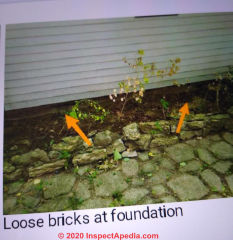
Abigail
It looks to me equally if there is reinforcing wire in a masonry wall and that a surface blanket or parching has popped off where the wires run close to the surface. That could be due to poor construction, although the near probable acquired use a water leak causing the steel to rust.
Hello! I have this issues on my walls and would like to know what they could be caused by and how to ready information technology. They are my kitchen walls. Behind it there is a banality. Is it just an esthetic problem or should I be concerned for the structure? Thanks in advance
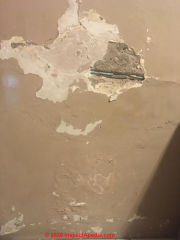
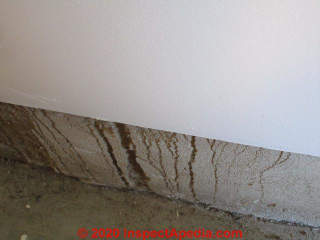 Alex said (re-posted by modern)
Alex said (re-posted by modern)
I am then deplorable, I accidentally deleted your bulletin and photograph - I am re-posting them below.
Comment:Today I saw these strange channels in the thick parging glaze on the interior of the garage wall. These are not stains, but actual grooves channeled through the cement.
The largest one is near inch deep. The colour is actually a shade created by light coming through the gate.
Any Idea what would these be and what might be a cause? Thanks.
Thank you for the interesting foundation wall harm photos and question, Alex.
H2o impairment to parge coating on foundation leaves rivulet-gouges:
My approximate is that there was a leak that occurred when the parge-coat was fresh - earlier information technology had hardened, and the leak washed abroad some of the coating.
Further investigation for hidden water damage or mold may be in social club.
I can't see plenty to know what's happening Sher, but if this is new or recently-set concrete, such as for a foundation or slab edge, and if it's un-coated concrete, then it looks like a void in the surface, peradventure where in that location was an air chimera or inadequate agitation every bit the concrete was poured confronting a class.
Is this spalling?
I had men tell me while ripping up concrete porch congenital with house - they covered it up with mesh wire mortar and waterproof but I seen where they need a different arroyo.
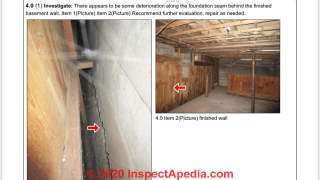
Thanks for the photos and query, Peter.
I cannot see plenty from this one photograph to offering a diagnosis with conviction simply certainly I agree that horizontal bang-up in a cake wall is due to pressure:
The worst case risk is of foundation collapse - not something I'grand asserting from your photos
I noted this on house inspection. Am I correct that this shearing from hydrostatic footing forces which shifted the whole foundation wall?
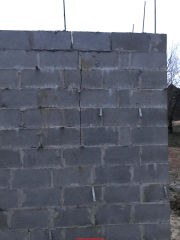 Todd
Todd
I am not smarter than your onsite engineer. I tin can notwithstanding offer some observations:
1. the vertical scissure suggests that the adjoining wall that is not visible has rotated outwards and will be out of plumb
2. the fissure pattern may indicate that the wall was built without sufficient steel reinforcement in the horizontal courses - or none; Adding that now is infeasible. (I do see some vertical rebar at intervals that helps protect confronting horizontal corking - buckling, merely one can't run across whatsoever horizontal)
3. where does the engineer intend adding re-bar? How will that prevent additional motion in these walls due to loading and future settling of fill up?
4. How much make full is being added inside this foundation wall - to what height? How volition the make full be compacted and so as to prevent future settlement?
v. Will the slab be pinned to the foundation walls or floating? What reinforcement will be used in the slab itself against settlement cracks?
Going to see what you thought near this.. nine and 1/two pes u block wall toward rear.. cracked when they were filling with fill.
Have 3 expert size cracks.
Engineer decided best thing to do was add rebar before pouring slab.
Picture I added was worse of the 3 cracks.
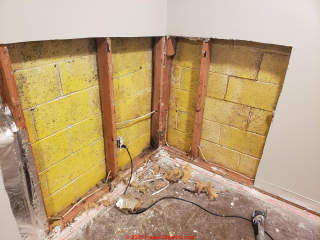 Pete
Pete
It'd exist no surprise to find some mold growth on physical block foundation walls, particularly where paint has been applied just also where there may exist organic dust and droppings.
The stair step scissure pattern is oft related to settlement or to frost heaves.
Take a look outside the aforementioned area for roof spillage, surface runoff, and accept a await inside for a history of water entry.
And then y'all'll desire to
review FOUNDATION Impairment SEVERITY
As I don't see obvious extensive h2o entry signs in your photo - such as rotted sill plates - it's possible that the mold is related to moisture penetration into what was a fiberglass-insulated wall cavity against cool concrete block foundation walls.
"A crystallization" might be mineral salts or effloresence left backside from foundation wall leakge.
Come across EFFLORESCENCE SALTS & WHITE DEPOSITS
Wondering your assessment on this cinder block...we had a h2o leak in the corner so we took downwardly the drywall and the insulation and this is what we see.
Looks like someone painted it xanthous but a contractor told united states of america that is not mold merely appears to be a crystallization?
I have a couple more pics but it looks like you but permit ane upload.
Thanks
Yea, I figured they just were likewise embarrassed to admit they were wrong. In the email that they suggested that I contact a structural engineer that is qualified to answer and assess the spalling. The funny affair is, their website says they specialize in all this. Oh well.
I came to question their cess as I was Googling spalling and concrete damage to educate myself -- the information I was finding conflicted with what they said.
Beingness wary of the pitfalls of internet research, I came to forums and pages similar this to pose my question then SMEs and sort out the discrepancies. Thanks to you I was able to confirm my behavior in what I found.
I ended upwards getting a mason out there who was really good at explaining everything and his assessment seems very reasonable. His cess is the re-bar swelled from rusting and broke upwardly the concrete from the inside. He then explained the other smaller cracks and what they could and couldn't mean and what they were probably acquired by.
Thanks again for having such an informative site and also for taking the fourth dimension to answer questions for u.s. commoners.
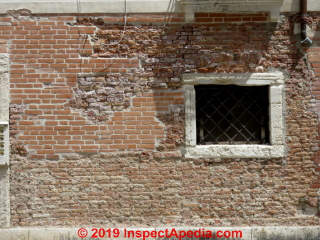
Spalling is defined as the flaking off or loss of material in masonry block, brick, concrete or other masonry structures, usually caused by the action of freezing water that has penetrated the masonry surface.
Spalling can also be acquired by the forces of mineral crystal or salt germination as wet passes through and evaporates from the surface of masonry materials, causing lifting off or flaking of the surface.
Spalling is usually used to depict flaking off of the surface of brick bolck or rock.
My photo is of desperately-spalling brick on the lower walls of a building in the Dosoduro section of Venice - a metropolis increasingly subjected to flooding and water damage equally tides are higher and storms more severe every bit global warming progresses.
In its most-general sense,
"Spalling" means "flaking off of the surface" of the material of a larter solid trunk of masonry - physical, concrete cake, brick, occasionally rock.
Definition of Spalling or Spall - A small fragment removed from the confront of a masonry unit of measurement by a blow or by action of the elements. - Masonry Institute - http://www.masonryinstitute.com/wp-content/uploads/MIW-Pocket-Guide.pdf
This is similar to my definition
The most-farthermost disintegrating concrete block in the photos I suggested earlier is in my opinion something worse than spalling - spalling is usually a surface defect.
But a concrete block that was made of improperly-mixed materials - for example chinching out on the corporeality of portland cement in an old concrete block or "cinderblock" can show up showtime as surface spalling but as the blocks are plant to be soft and crumbling and literally disintegrating I would consider that to be a fabric defect in the original manufacture of the cake - and very serious if the cake is part of a structure.
(That'south non your block).
In my opinion the reason that it is actually important to telephone call masonry impairment past its correct name is that the agreement type of harm (cracks, spalling, jutting, leaning, settlement, heaving etc) is absolutely critical in diagnosing the cause, assessing the bear on, and prescribing necessary actions.
If my physician can't tell the difference betwixt a cleaved bone (a very severe "crack") and heat rash (a skin surface condition) then I doubt that she will make a useful diagnosis and her prescription for treatment is ... well ... going to exit me nervous as all become-out. Same for my "engineer".
Engineers vary considerably in their bodily specific training: structural, civil, chemical, mechanical, electrical, for example. It sounds to me equally if either at that place has been a serious mis-communication somewhere or your engineer isn't familiar with masonry structure.
 Spalling is usually caused by water penetration of the surface of masonry, oft combined with freezing, to force off flakes of material from the surface of the masonry brick or block or occasionally concrete surface. Spalling e'er occurs kickoff at the surface of masonry.
Spalling is usually caused by water penetration of the surface of masonry, oft combined with freezing, to force off flakes of material from the surface of the masonry brick or block or occasionally concrete surface. Spalling e'er occurs kickoff at the surface of masonry.
Cracks occur from mechanical forces such as affect, bending, settling, heaving that cause actual breakage of the material (as the most-common crack though there are likewise "shrinkage" cracks in concerete and thermal expansion cracks in brick).
In all cases in that location is a mechanical force and a breaking of the material in lines or ... cracks.
This photo is a vertical fissure near the corner of a concrete block wall.
This is Not spalling.
Compare it to your photo. Your wall scissure is also roughly vertical just not as straight.
Mike that is indeed disappointing - or we're not looking at the same matter.
Spalling is a aging or flaking off of the surface of masonry - in your example masonry block.
Cracks appear as lines or gaps between surfaces of the cloth. You *might* see a little weathering at the very edges of such cracks at the outer surface of the block but no stonemason would telephone call cracking spalling.
With all due respect to your engineers, you might want to look
at SPALLING Physical Block WALLS & CHIMNEYS
where you will run across thin spalling that was painted over, and such astringent block spalling that an entire thickness of the cake wall has been lost - in other photos.
Spalling: think flaking or crumbling.
Cracking: remember separation in masonry forming a linear gap, usually irregular, of varying width depending on the crack type and severity.
There is one case in which we might run across a bit of concrete block that chipped away along the edge of a crevice - I'll attach a photograph. Notwithstanding if yous look with whatever sense at all at the photograph you'll see that the chip occurs along the edge of a crack; this is crack damge. Spalling is shown at the link I gave.
Sometimes people are embarrassed to admit they made a mistake or don't know something. In my opinion we gain credibility rather than lose it when nosotros get in clear that we're not going to keen or B.S. the client.
I simply got an email reply from that structural engineering company. They looked at the photos I sent and still say information technology's spalling. I guess that would be the first clue to not hire them for any structural technology work. LOL
I'd look carefully at footings and floor-wall junctures for motion, water entry, insect set on through gaps;
More often than not when a wall tips or leans the distance and separation is greater higher in the structure;
I'm glad to hear that it is repairable, that is a relief. Now I but have to find out how involved and expensive a set up will be.
Given this impairment, are there other things I should be keeping a lookout for or be enlightened of?
Thanks for the information and confirming I'm non crazy. I was pretty sure it wasn't spalling only was doubting myself after that guy from a structural engineering science company said information technology was. .
Oftentimes in that location the type of crack that your photo shows is beingness caused by a rotating or tipping of the footing on which the wall rests.
Ultimately the wall may need to exist repaired or to exist pinned back to the remaining foundation wall.
In a severe case it may exist necessary to repair the supporting footing first.
At the very least you will want to continue roof spillage and h2o away from the foundation and basis to reduce that rate of settlement or movement.
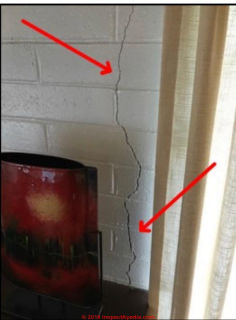 Yes, the house is on a slight gradient and the crevice is on the downhill side.
Yes, the house is on a slight gradient and the crevice is on the downhill side.
There are some horizontal cracks effectually the corner high on the wall. I thought it was settling or shifting only I tin can't find any cracks in the foundation or in the cement walkway that goes in front end of and around the side of the house in that area.
Of course it's not spalling, Mike, your photo shows a vertical crack, irregular, passing through the conceret blocks near a building corner.
Is this firm congenital on a slope or Hillside?
Is this fissure on the downhill side?
Could you please give your opinion on this wall? The firm was built in 1955 with concrete blocks. Information technology's located in a tropical and rainy climate. The house has several cracks on the outside walls. At that place are ii vertical cracks that go up each side of a window and are about 5' long.
They are on both sides of the wall -- I'1000 assuming they go completely through the brick. Effectually the corner and high on the wall there are a couple of horizontal cracks about 2' long. The crack width is pocket-size in comparing to the vertical cracks. In that location are no cracks in the foundation or walkway that goes around the house
. When I called a local visitor, the guy on the phone said it was spalling without looking at whatever photos. From what I can notice on your site (and other searches), this does not look like spalling. I have several photos but the site only lets me upload one.
I'd like to see photos, Pam (y'all can postal service one per comment) only I can in the interim suggest
1. the lower wall may have been pushed in past frost or earthloading just the break occurred at a mortar joint near the wall superlative where the top form of block are perchance pinned to the sill plate
ii. less common except in earthquake areas - the building framing was shifted or moved horizontally - in which example typically you'd see the identical harm on the 2 opposing foundation wall sides
I'm a bit confused by the latter part of your question: a wall can't too be a driveway, right?
showtime row of blocks re ceiling of crawl infinite, horizontal 6 ft. crack 3- four blocks , slight lean, towards the EXTERIOR OF THE Dwelling.
note yes the blocks are to code over xvi inch below frost line
nosotros alive in Ontario Canada.... unfortunately my married man did not observe this upshot until now
why would cause the blocks to lean towards the exterior of home, the wall in question is a interlock brick driveway that is sloped down towards the road
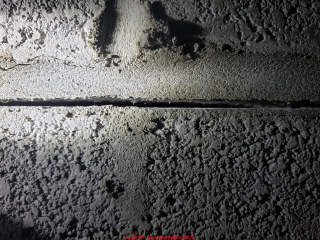
Should these cracks be sealed with mortar filler to avoid moisture coming into the basement?
...
Continue reading at BLOCK FOUNDATION BACKFILL Impairment or select a topic from the closely-related articles below, or meet the complete ARTICLE Index .
Or see BLOCK FOUNDATION WALL DAMAGE FAQs - questions and answers posted originally on this page
Or run into these
Recommended Manufactures
- Cake FOUNDATION & WALL DEFECTS - home
- BLOCK FOUNDATION BACKFILL Impairment
- BULGE or LEAN MEASUREMENTS
- BULGED vs. LEANING FOUNDATIONS
- DIAGONAL CRACKS in Block FOUNDATIONS, WALLS
- SPALLING Physical BLOCK WALLS & CHIMNEYS
- VERTICAL CRACKS in Cake WALLS
- Cake WALL INSULATION RETROFIT
- Physical or MASONRY DAMAGE TESTS
- FOUNDATION CRACK DICTIONARY for descriptions of different cleft patterns, causes, repairs
- FOUNDATION DAMAGE & REPAIR GUIDE - home
- FOUNDATION DAMAGE SEVERITY
- FOUNDATION FAILURES by Move TYPE - dwelling
- FOUNDATION FAILURES by Blazon & Fabric - home
- FOUNDATION INSPECTION STANDARDS
Suggested citation for this spider web page
Block FOUNDATION & WALL DEFECTS at InspectApedia.com - online encyclopedia of building & environmental inspection, testing, diagnosis, repair, & problem prevention advice.
Or see this
Index to RELATED ARTICLES: Commodity INDEX to Edifice STRUCTURES
Or utilize the SEARCH BOX plant below to Enquire a Question or Search InspectApedia
...
Ask a Question or Search InspectApedia
Questions & answers or comments near damaged concrete block foundations: causes, crack & move patterns, diagnosis, repair, inspection procedures..
Try the search box just below, or if you prefer, postal service a question or annotate in the Comments box below and we will answer promptly.
Search the InspectApedia website
Note: appearance of your Comment beneath may be delayed: if your comment contains an image, web link, or text that looks to the software equally if it might be a web link, your posting will announced later on information technology has been approved by a moderator. Apologies for the delay.
Technical Reviewers & References
Click to Show or Hibernate Citations & References
Publisher InspectApedia.com - Daniel Friedman
Source: https://inspectapedia.com/structure/Block_Wall_Defects.php
Posted by: guildwiffor.blogspot.com


0 Response to "How To Repair Damaged Cinder Block Wall"
Post a Comment